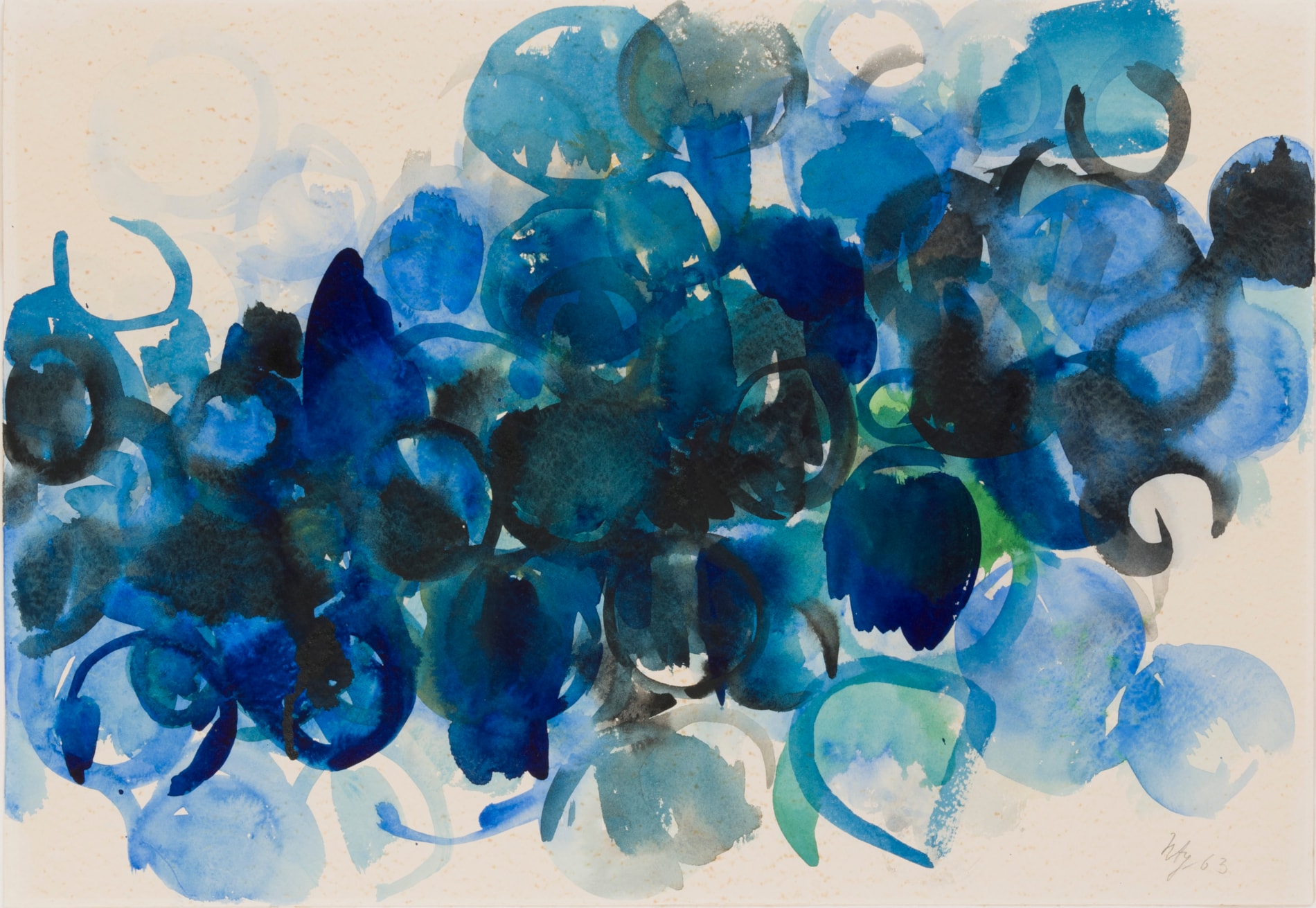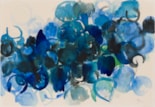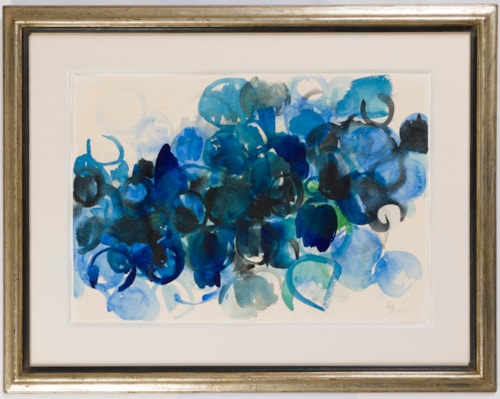Ernst Wilhelm NAY
(Berlin 1902 - Cologne 1968)
Ohne Titel (Untitled), 1963
Watercolour on paper.
Signed and dated nAy 63 at the lower right.
419 x 602 mm. (16 1/4 x 23 3/4 in.)
Signed and dated nAy 63 at the lower right.
419 x 602 mm. (16 1/4 x 23 3/4 in.)
This large watercolour by Ernst Wilhelm Nay may be associated with a group of abstract works on paper produced during the second half of the 1950s and the first half of the 1960s, in which rounded or circular shapes (which the artist referred to as ‘discs’) are repeated to create an almost floral effect. These works are closely related to both the artist’s critically acclaimed 'Scheibenbildern', and the successive series of 'Augenbilder', or ‘eye paintings’ of 1963-1964, in which the disc motifs were developed into eye-like forms. Executed in 1963, the year in which Nay undertook a long trip to California and Mexico, this untitled watercolour may be likened to several works of this period in which a bluish tonality is predominant, such as Ohne Titel (Aquarellstudie Blau) of 1956, Aquarell Blau of 1958, Ohne Titel of 1960 and Ohne Titel (Aquarell Blau) of 1962, all in private collections. A particularly close comparison may be made with a large watercolour of the same date and dimensions, entitled Composition 2, formerly in the Rockefeller collection and sold at auction in New York in 2018.
The present sheet, which was until recently in the collection of the renowned German banker Robert Ehret (1925-2022), is registered in the online Ernst Wilhelm Nay catalogue raisonné, under no.CR 63-0112.
The present sheet, which was until recently in the collection of the renowned German banker Robert Ehret (1925-2022), is registered in the online Ernst Wilhelm Nay catalogue raisonné, under no.CR 63-0112.
Arguably the most significant German artist of the post-war period, the painter and graphic artist Ernst Wilhelm Nay was self-taught until 1924, when he showed three of his paintings to the Expressionist artist Karl Hofer. He thereby earned a scholarship to Hofer’s studio of at the College of Fine Arts in Berlin, and in 1927 became Hofer’s Meisterschüler. After his graduation in 1928, Nay undertook a study trip to Paris, followed by a stay on the Baltic island of Bornholm in Denmark in 1930 and a fellowship to study in Rome in 1931. The artist was to be an inveterate traveller throughout his career. In 1932-1933 he was one of the artists included in the exhibition ‘Living German Art’, organized in Berlin by the art dealers Albert Flechtheim and Grete Ring and one of the last exhibitions of modern art to be held in Germany before the rise to power of the National Socialists. In 1937 Nay had his first solo exhibition at the Galerie Bucholz in Berlin, but the same year two of his paintings were included in the Nazi party’s notorious Entartente Kunst (‘Degenerate Art’) exhibition, and he was soon banned from exhibiting his work or purchasing art supplies. With the financial support of the artist Edvard Munch, Nay was able to travel to Norway, where he spent several months in 1937 and 1938 and painted a series of large-scale watercolours. During his military service during the Second World War, he was able to continue working in his spare time, and in 1943 had an exhibition of his works on paper at a gallery in Munich. Soon after the end of the war, he left Berlin – where his home and studio had been destroyed by bombing – and settled in the town of Hofheim am Taunus, near Frankfurt. In 1946 and 1947 he had exhibitions at galleries in Munich, Berlin, Düsseldorf and Cologne, and it was around this time that his paintings began to get more abstract. A first retrospective exhibition of his work was held at the Kestner-Gesellschaft in Hannover in 1950, and the same year he participated in the Carnegie International exhibition in Pittsburgh. In 1951 Nay moved to Cologne, where he was to live and work for the remainder of his career.
The 1950s and 1960s found Nay fully embracing colour and abstraction in his work as a painter, watercolourist and printmaker. It was during a six-week stay on the coast of Jutland in northern Denmark in August and September 1954, followed by a visit to Crans-Montana in the Swiss Alps in February and March 1955, that he began to work on what were to become probably his best-known works; the Scheibenbildern, or ‘disc pictures’, created between 1954 and 1963, in which round shapes predominate. As the artist wrote of these large-format paintings and watercolours, ‘I started with very innocuous new experiments and found out: If I go with a brush on the canvas, there is a small blob, I enlarge that, then I have a disc. This disc is of course already doing a lot on the surface. If I add other slices, then a system of at least coloured and quantitative proportions is created, which can now be combined and further assembled into larger image complexes.’ Among the most public of these Scheibenbildern was a monumental mural, measuring nearly six and half metres in length, painted in 1956 for the chemical building of the University of Freiburg im Breisgau.
Nay’s international reputation began to grow in the 1950s. His work was included in the first, second and third editions of the Documenta exhibition of contemporary art in Kassel, in 1955, 1959 and 1964 (when several of his works were hung on the ceiling), while an exhibition in America in 1955 and a solo presentation in the German pavilion at the Venice Biennale the following year added to his standing outside Germany. In 1960 the first monograph devoted to Ney’s work was published, and two years later a large retrospective exhibition was held at the Folkwang Museum in Essen, on the occasion of the artist’s sixtieth birthday. Nay remained working right until his death, from heart failure, in 1968. Works by him are today in the collections of numerous museums in Germany, as well as in museums in Basel, Brussels, Detroit, London, Milwaukee, New York, Paris, Saint Louis and Vienna. In 2022 a major retrospective of 120 paintings, watercolours and drawings by Nay was mounted at the Kunsthalle in Hamburg.
The 1950s and 1960s found Nay fully embracing colour and abstraction in his work as a painter, watercolourist and printmaker. It was during a six-week stay on the coast of Jutland in northern Denmark in August and September 1954, followed by a visit to Crans-Montana in the Swiss Alps in February and March 1955, that he began to work on what were to become probably his best-known works; the Scheibenbildern, or ‘disc pictures’, created between 1954 and 1963, in which round shapes predominate. As the artist wrote of these large-format paintings and watercolours, ‘I started with very innocuous new experiments and found out: If I go with a brush on the canvas, there is a small blob, I enlarge that, then I have a disc. This disc is of course already doing a lot on the surface. If I add other slices, then a system of at least coloured and quantitative proportions is created, which can now be combined and further assembled into larger image complexes.’ Among the most public of these Scheibenbildern was a monumental mural, measuring nearly six and half metres in length, painted in 1956 for the chemical building of the University of Freiburg im Breisgau.
Nay’s international reputation began to grow in the 1950s. His work was included in the first, second and third editions of the Documenta exhibition of contemporary art in Kassel, in 1955, 1959 and 1964 (when several of his works were hung on the ceiling), while an exhibition in America in 1955 and a solo presentation in the German pavilion at the Venice Biennale the following year added to his standing outside Germany. In 1960 the first monograph devoted to Ney’s work was published, and two years later a large retrospective exhibition was held at the Folkwang Museum in Essen, on the occasion of the artist’s sixtieth birthday. Nay remained working right until his death, from heart failure, in 1968. Works by him are today in the collections of numerous museums in Germany, as well as in museums in Basel, Brussels, Detroit, London, Milwaukee, New York, Paris, Saint Louis and Vienna. In 2022 a major retrospective of 120 paintings, watercolours and drawings by Nay was mounted at the Kunsthalle in Hamburg.
Provenance
Private collection, Konigstein im Taunus
Anonymous sale, Frankfurt am Main, Auktionshaus Wilhelm M. Döbritz, in 1977
Robert and Helga Ehret, Frankfurt am Main.
Anonymous sale, Frankfurt am Main, Auktionshaus Wilhelm M. Döbritz, in 1977
Robert and Helga Ehret, Frankfurt am Main.





